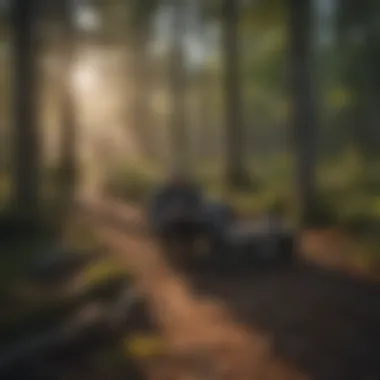Discovering the Best Campgrounds on Minnesota's North Shore


Intro
The North Shore of Minnesota offers a remarkable blend of natural splendor and diverse camping opportunities. With its stunning views of Lake Superior, dense woodlands, and varied wildlife, this region attracts many outdoor enthusiasts. This guide provides a detailed exploration of campgrounds along the North Shore, focusing on their unique features, amenities, and surrounding ecosystems. Whether you are a novice camper seeking a peaceful spot or a seasoned adventurer looking for amenities that support your outdoor activities, this article will serve as a useful resource.
Understanding Woodland Ecosystems
Woodland ecosystems are invaluable to our planet. They sustain diverse species, moderate climate conditions, and provide resources for the surrounding communities. Understanding these ecosystems is crucial for anyone looking to explore the campgrounds along the North Shore. Knowledge of the local flora and fauna enhances the camping experience and fosters appreciation for nature’s interconnectedness.
Importance of Biodiversity in Forests
Biodiversity refers to the variety of life within an ecosystem. This diversity is essential for maintaining ecological balance. In the forests along the North Shore, various species of trees, plants, and animals coexist. Healthy ecosystems can withstand environmental changes better, which is increasingly important in our changing climate. Campers should recognize this biodiversity and aim to minimize their impact on these critical habitats.
Role of Forests in Climate Regulation
Forests play a vital role in climate regulation. They act as carbon sinks, absorbing carbon dioxide from the atmosphere. This process helps mitigate climate change. The North Shore’s woodlands contribute significantly to this global effort. Campers can engage in practices that support forest health, such as proper waste disposal and respecting fire regulations.
Sustainable Camping Practices
Practicing sustainability while camping is essential for preserving the natural beauty of the North Shore. Campers can contribute to environmental stewardship through careful planning and mindful actions.
Principles of Sustainable Camping
- Leave No Trace: Always pack out what you pack in. Minimize waste and avoid disturbing wildlife.
- Respect Local Regulations: Follow the guidelines established by campground management. These regulations are in place to protect both visitors and ecosystems.
- Use Designated Trails: Stick to marked pathways to minimize trail widening and vegetation trampling.
Understanding and applying these principles is fundamental to enjoying the serene beauty of North Shore campgrounds.
Epilogue
Exploring the North Shore of Minnesota offers unique opportunities for campers. The woodlands, rich in biodiversity, provide a perfect backdrop for various outdoor activities. By understanding woodland ecosystems and practicing sustainability, campers can nurture their love for nature while responsibly enjoying the outdoors. This guide aims to equip you with the knowledge needed to make informed decisions and elevate your camping experience in this scenic region.
Preamble to the North Shore
The North Shore of Minnesota presents a convergence of serene landscapes and rich ecological diversity. This region, celebrated for its scenic views of Lake Superior, offers numerous opportunities for outdoor enthusiasts, particularly campers. Understanding the North Shore's geographic context and natural features is essential to appreciate the campgrounds located here. Such knowledge enriches the camping experience, ensuring that visitors select sites aligned with their interests and needs while fostering respect for the environment.
Geographic Overview
The North Shore stretches approximately 150 miles along the northeastern shore of Lake Superior. It includes significant towns such as Duluth, Two Harbors, and Grand Marais. The region is characterized by rugged coastlines, dense forests, and rolling hills, all contributing to its distinctive landscape. Each campground offers varied proximity to the lake, accessibility to hiking trails, and insights into local fauna and flora.
Additionally, the North Shore is home to several state parks, each with its unique offerings. For example, the proximity to the North Shore Scenic Drive provides easy access for campers and sightseers. Overall, this geographical backdrop forms an integral part of the camping experience, enabling visitors to engage with both nature and local culture.
Natural Features
The North Shore is rich in diverse natural features, making it a prime locale for camping. Towering cliffs, sprawling forested areas, and pristine beaches characterize the landscape. The region is also home to waterfalls, such as those found in Gooseberry Falls State Park, enhancing its visual appeal and offering recreational activities.
The unique geology of the area, shaped by volcanic activity and erosion, creates striking rock formations that define its beauty. Additionally, the ecosystems here support a variety of wildlife, including deer, eagles, and diverse aquatic species. This biodiversity not only adds to the aesthetic of camping but also emphasizes the importance of conservation efforts. Campers are encouraged to respect the natural habitats and engage in sustainable practices to preserve these resources for future generations.
"By understanding the geography and natural wonders of the North Shore, campers can foster a deeper connection with the environment."
Knowledge of the North Shore allows campers to select sites that offer specific amenities and activities that cater to their preferences. It ensures that the experience is not just about camping but about immersing oneself in a remarkable landscape.
Importance of Camping in Natural Settings
Camping in natural settings plays a pivotal role in enhancing both individual well-being and fostering a deeper connection with the environment. Engage with nature creates opportunities for physical activity, mental relaxation, and social bonding. This article emphasizes these importance, focusing on how immersion in the wilderness can lead to numerous personal and ecological benefits.
Benefits of Outdoor Experiences
Engaging with nature through camping has various psychological benefits. Research indicates that spending time outdoors can significantly reduce stress levels. The tranquil landscapes of North Shore provide a backdrop for healing and reflection.


- Physical Health: Outdoor activities such as hiking, swimming, and biking contribute to improved cardiovascular health. The North Shore's diverse terrain offers ample opportunities for such activities.
- Mental Clarity: Nature has a calming effect. Studies show exposure to nature can boost creativity and cognitive functions. This is particularly true in the numerous parks along the North Shore.
- Social Connections: Camping together fosters relationships. Building campfires or hiking can strengthen bonds among families and friends. These shared experiences are invaluable in today's fast-paced world.
Outdoor experiences encourage a sense of adventure, prompting individuals to explore and learn. This exploration can lead to a greater appreciation of biodiversity, leading us to be more responsible custodians of these precious natural resources.
Role of Campgrounds in Conservation
Campgrounds serve more than just a place to sleep; they are crucial hubs for conservation efforts. They create a bridge between nature and visitors, allowing opportunities to educate the public about ecological sensitivity.
- Preservation of Natural Areas: Many campgrounds are situated in protected zones, playing a vital role in preserving landscapes that might otherwise face development pressures. They help maintain biodiversity.
- Environmental Education: Well-managed campgrounds often include educational signage and programs that inform visitors about local wildlife and habitats. This education fosters a sense of stewardship, encouraging them to respect and protect these areas.
- Sustainable Practices: Many campgrounds are adopting sustainable practices, such as waste reduction initiatives and water conservation measures. This not only benefits the local ecosystem but also sets a precedent for visitors to follow in their own lives.
Types of Campgrounds in North Shore
Understanding the different types of campgrounds along Minnesota's North Shore is crucial for anyone planning a visit. Each type offers unique experiences, catering to varying preferences and requirements. From serene state parks to private campgrounds and expansive national forests, the options are diverse. Knowing these distinctions can enhance your camping experience and ensure a more enjoyable stay in this picturesque region.
State Parks
State parks in North Shore provide well-maintained facilities amidst stunning natural settings. These areas typically offer amenities such as restrooms, picnic areas, and marked trails for hiking. The parks often feature a range of camping options, including tent sites and RV hookups.
One notable example is Gooseberry Falls State Park. It is famous for its waterfalls and scenic views. Here, visitors can enjoy not just camping but also hiking, fishing, and exploring nearby trails. Another advantage of state parks is their commitment to conservation. They often have educational programs and guided tours to promote environmental awareness.
Private Campgrounds
Private campgrounds offer a different experience compared to state parks. They may have additional amenities, such as cabins, water activities, and organized events. These campgrounds often emphasize family-friendly activities, making them ideal for those traveling with children.
A popular private campground along the North Shore is the Rustic Cabins in Lutsen. This site combines comfort with nature, offering cabins that allow for a more home-like atmosphere while still being close to the outdoor experiences. Choosing a private campground can provide a balance of amenities and nature immersion.
National Forests
National forests present another layer of camping opportunities, offering more primitive camping experiences. Such sites usually lack developed facilities, appealing to those seeking tranquility and adventure. Visitors to Tettegouche National Forest, for instance, can immerse themselves in the wilderness. Here, camping might involve hiking to remote spots, fishing in untouched lakes, and observing wildlife in its natural habitat.
Some considerations when choosing a national forest include the need for self-sufficiency and an understanding of wilderness safety. Campers must be prepared for potential challenges as these areas often require knowledge of camping regulations and environmental preservation practices.
In summary, the types of campgrounds along the North Shore are varied and cater to different preferences. Understanding these options helps campers make informed decisions about their outdoor experiences.
Key Campgrounds Along North Shore
The campgrounds along Minnesota's North Shore present distinct opportunities for adventurers and families alike. These areas are not just scenic spots to pitch a tent; they are gateways to unique experiences in nature. Each campground provides specific amenities, activities, and environmental considerations that can enhance the camping experience.
Gooseberry Falls State Park
Facilities and Amenities
Gooseberry Falls State Park offers essential facilities that contribute significantly to the camping experience. It has well-established campsites with access to restrooms, showers, and potable water. The picnic areas are strategically located, allowing campers to enjoy the picturesque views while dining. This setup makes it a popular choice for families seeking comfort without sacrificing engagement with nature. A unique aspect is the proximity to the falls, which provides both aesthetic pleasure and a natural soundscape that enhances the atmosphere of the park.
Activities Available
The activities available at Gooseberry Falls are diverse. Hiking trails cater to all levels, allowing for exploration of the area's remarkable geology and flora. Fishing enthusiasts find opportunities in the river, while children can engage in ranger-led programs, enriching their knowledge about the environment. The waterfall trails are particularly popular, providing a blend of activity and natural beauty. However, during peak seasons, the high visitor numbers can lessen the sense of solitude, which some campers might seek.
Environmental Considerations
Environmental stewardship is a focal point at Gooseberry Falls. Campers are encouraged to follow the Leave No Trace principles, which minimize human impact on the environment. The park conducts outreach about local wildlife, emphasizing the importance of maintaining natural habitats. This balance of recreation and conservation makes Gooseberry Falls an ideal location for responsible camping, although the potential for overuse during busy seasons raises concerns for sustainability.
Tettegouche State Park
Natural Attractions
Tettegouche State Park is renowned for its dramatic cliffs and beautiful vistas along Lake Superior. The natural attractions constitute a significant part of its appeal. Many visitors find the high vantage points rewarding after a hike, providing panoramic views that are photogenic and spiritually uplifting. The Silver Bay area includes waterfalls and unique rock formations, making this park a must-visit. However, these beautiful spots can also attract large crowds, which may detract from personal experiences for some.


Camping Options
Camping at Tettegouche is varied, with options for tent and RV camping. sites are equipped with fire rings and picnic tables, enhancing the experience for campers. The layout of the campground provides space for solitude while still being accessible to park amenities. However, reservations can fill up quickly during the summer, necessitating planning ahead.
Visitor Information
Obtaining visitor information is crucial at Tettegouche. Information centers provide maps, program schedules, and guidance on the trails. Campers benefit from educational materials about the unique ecosystems present in the park. This vital information aids in trip planning and ensures a safe and engaging experience. Knowledge of weather patterns, which can change rapidly, is also essential for a successful visit.
Split Rock Lighthouse State Park
Historical Significance
Split Rock Lighthouse State Park holds historical significance as one of the most photographed lighthouses in the United States. Established in 1910, the lighthouse is a testament to maritime safety and offers insights into the region's history. Visitors can explore the lighthouse through guided tours, gaining an understanding of its function and the lives of those who maintained it. This historical context enriches the overall camping experience, although some may find the educational aspects less engaging when focused solely on outdoor activities.
Camping Experience
The camping experience at Split Rock is enhanced by its stunning location. Sites are nestled among towering trees, providing privacy and an immersive nature experience. Campers can enjoy evening strolls along the rugged coast, with the sound of waves serving as a soothing backdrop. However, amenities like restrooms are limited, which may require campers to plan accordingly.
Surrounding Activities
Surrounding activities include hiking and biking trails that connect to the North Shore State Trail. These offer both challenges and scenic beauty, facilitating active exploration. Visitors also find opportunities to learn through various interpretive programs. The drawbacks are the potential for crowded trails during peak seasons, which can limit the sense of isolation some might seek when camping.
Judge C. R. Magney State Park
Scenic Aspects
Judge C. R. Magney State Park is known for its stunning scenic aspects, including the picturesque Devil's Kettle waterfall. The park's rugged terrain offers stunning views and diverse landscapes, appealing to photographers and nature lovers. The aesthetics are essential for enhancing the camping experience. However, uneven terrain may limit accessibility for those with mobility challenges, which can be a drawback for some.
Trail Access
Trail access at Judge C. R. Magney is integral to its appeal. A network of trails varies in difficulty, accommodating both casual walkers and serious hikers. Trails lead to the dramatic viewpoints that showcase the beauty of the North Shore. However, some trails are steep and can be challenging, requiring careful navigation, especially in wet conditions.
Community Engagement
Community engagement is encouraged at Judge C. R. Magney through various volunteer programs and events. These initiatives create a strong connection between the park and visitors, enhancing shared responsibility for its upkeep. However, varied levels of visitor participation can result in inconsistency in community efforts, which may affect overall engagement.
"Understanding local parks not only enhances the camping experience, but also fosters a sense of responsibility toward conservation."
Planning Your Camping Trip
Planning your camping trip is crucial to maximize both enjoyment and safety during your time on the North Shore. The unique ecosystems and natural beauty of this area require careful consideration of various factors. This section aims to equip campers with the necessary insights to prepare effectively for their adventure in this picturesque region.
Importance of Research
Before embarking on a trip, research is paramount. Understanding the specific campgrounds offers insights into what each location provides. This includes amenities, layout, and allowed activities. Different campgrounds cater to different preferences. Some are ideal for family camping, while others might appeal more to seasoned backpackers. Knowing the rules and facilities at each site is essential for a pleasant experience.
Additionally, researching the climate is important. The North Shore can present a range of weather conditions throughout the year. Campers should check forecasts and historical weather patterns to prepare suitable gear. Doing so will help avoid uncomfortable situations or even dangers associated with severe weather.
Understanding Reservations
Many campgrounds along the North Shore require a reservation to secure a spot, especially during peak seasons. It is necessary to understand the reservation systems in place. Some campgrounds may use online platforms, while others rely on phone bookings or walk-in protocols. Familiarizing yourself with these processes can prevent disappointments upon arrival.
It is worth noting that some sites adopt first-come, first-served policies. An awareness of a campground’s reservation requirements allows campers to plan their trip timetable better.
Safety Considerations
Safety cannot be overlooked when camping. Each campground on the North Shore presents distinct risks that campers must address. Familiarize yourself with the wildlife in the area, such as bears or moose, and understand the best practices for coexistence. Store food securely, and know where to dispose of waste properly.


Furthermore, understanding the terrain is important for assessing hiking routes or water access. Maps or guides should be studied beforehand, and carrying a first aid kit is a must. Beyond personal safety, being aware of local regulations can prevent unnecessary fines or interruptions.
In summary, systematic planning through research, reservation management, and safety preparedness can greatly enhance the camping experience on the North Shore. With careful execution of these elements, campers are more likely to enjoy their time in this remarkable setting.
Environmental Stewardship for Campers
Environmental stewardship is vital for campers who wish to enjoy the beautiful landscapes of the North Shore of Minnesota. Campgrounds are not merely places for recreation; they are part of an interconnected ecosystem. Understanding how to protect these natural spaces can enhance the camping experience while ensuring their preservation for future generations.
The act of camping comes with the responsibility to engage in practices that mitigate environmental impact. Campers contribute to the conservation of the environment by adopting mindful habits. This means respecting wildlife, minimizing waste, and adhering to regulations set forth by land management agencies. When individuals camp responsibly, they foster ecosystems that can endure human activity while still providing enjoyment.
Additionally, responsible camping helps maintain the beauty and ecological integrity of campgrounds. It encourages future visitors to appreciate nature without causing harm. By emphasizing environmental stewardship, we can ensure that these natural wonders remain accessible and vibrant.
Leave No Trace Principles
Leave No Trace is a set of guiding principles designed to educate outdoor enthusiasts about their responsibilities while exploring nature. The principles include:
- Plan Ahead and Prepare
- Travel and Camp on Durable Surfaces
- Dispose of Waste Properly
- Leave What You Find
- Minimize Campfire Impact
- Respect Wildlife
- Be Considerate of Other Visitors
- Proper preparation prevents unexpected problems.
- Knowledge of area regulations is essential.
- Stick to existing trails and campsites to reduce damage to vegetation.
- Pack out what you pack in, including all trash and leftover food.
- Preserve the natural and cultural features by not removing rocks, plants, or historical artifacts.
- Use a stove for cooking and follow fire regulations; observe campfire restrictions where applicable.
- Observe animals from a distance and do not feed them. Human food can harm them.
- Keep noise levels down and maintain privacy for others.
These principles serve as a framework that guides campers toward minimizing their impact on the environment. By adhering to them, campers can enjoy the North Shore’s beauty while ensuring that they protect it for those who will follow.
Wildlife Considerations
When camping in areas known for rich biodiversity, understanding the local wildlife is crucial. Campers should take several considerations into account to safeguard both themselves and the animals they encounter.
- Food Storage: Improper storage of food attracts wildlife and poses dangers. Using bear-resistant containers or hanging food at a height can prevent unwanted encounters.
- Wildlife Encounters: It is important to familiarize oneself with local species. Respect their space and observe from a distance. Most wildlife is not aggressive but can act defensively if threatened.
- Habitat Protection: Avoid walking off-trail in sensitive areas. Many animals nest or breed in specific locations. Disturbance can have lasting impacts on populations.
According to a study by the U.S. Forest Service, camping activities significantly affect wildlife behavior, showing that even human presence can alter their patterns.
By prioritizing wildlife considerations, campers contribute to healthier ecosystems. Enjoying nature while respecting its inhabitants promotes a sustainable camping culture. Understanding the balance between recreation and conservation is fundamental for the continued enjoyment of the North Shore’s campgrounds.
The End
The conclusion serves as an essential anchor in the discussion of camping along the North Shore of Minnesota. It synthesizes the various themes explored in the preceding sections, emphasizing the significance of these camping experiences and their broader implications. By reflecting on the North Shore experience, readers grasp the allure of this unique region and appreciate the chance to connect deeply with nature.
Reflection on the North Shore Experience
Camping on the North Shore offers more than just a place to pitch a tent. It provides an opportunity to immerse oneself in a landscape dominated by rugged cliffs, lush forests, and the remarkable shores of Lake Superior. Each campground presents distinct characteristics, from the cascading waterfalls of Gooseberry Falls State Park to the historical ambiance at Split Rock Lighthouse State Park. Campers are not merely observers; they are participants in a living ecosystem. Their experiences can evoke feelings of tranquility, adventure, and connectivity that modern life often lacks.
Immortalized by the trails and the waters, campers often share stories and memories shaped by the surroundings. Engaging in activities like hiking, kayaking, or simply stargazing becomes a means of fostering a deeper understanding of the natural world. As one reflects on these experiences, it becomes clear that the North Shore is not just a destination but a catalyst for personal growth and appreciation of the environment.
Future of Campgrounds in the Region
Looking ahead, the future of campgrounds in the North Shore region faces both opportunities and challenges. Given the popularity of outdoor recreational activities, there is potential for growth in available facilities and improved access to natural areas. This could lead to sustainable practices being integrated into campground operations, addressing the balance between visitor access and ecological preservation.
There is also an increasing awareness among campers about environmental stewardship. This consciousness could prompt the development of more eco-friendly campgrounds. Innovations such as solar-powered sites and graywater recycling could redefine the camping experience, aligning it with modern sustainability standards.
However, this growth must be navigated carefully. As more visitors are drawn to the North Shore, it is crucial to monitor the area's ecological integrity. Effective management strategies will play a pivotal role in ensuring that the pristine nature of the landscape is preserved for future generations of campers, while still providing a rich, engaging experience for today's visitors.
In summary, the North Shore of Minnesota stands not only as a recreational paradise but also as a vital resource for education and conservation through its campgrounds. With mindful planning and a commitment to sustainability, the future will hold numerous possibilities that enhance both the visitor experience and environmental conservation.







